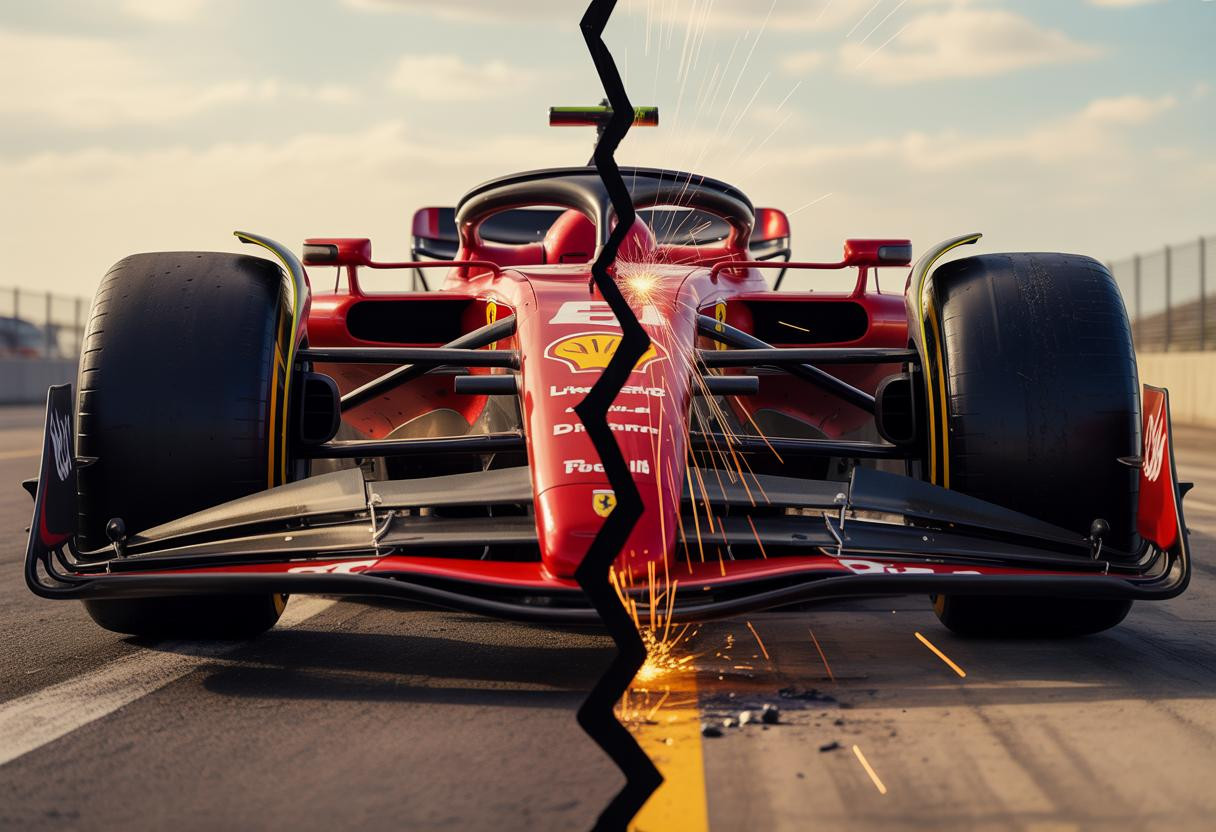When Charles Leclerc’s frustrated radio crackled through team communications calling the SF-25 “undriveable,” it wasn’t just another driver complaint—it was the surface crack revealing Ferrari’s deepest crisis in years. Behind those brutal exchanges lies a technical and organizational meltdown that could reshape Formula 1’s most iconic team, with implications extending far beyond 2025.
The technical nightmare hidden beneath radio frustration
Ferrari’s 2025 struggles stem from a catastrophic gamble on radical redesign. The SF-25’s switch to pull-rod front suspension, intended to optimize aerodynamic flow, has created a cascade of performance-destroying issues that make the car genuinely difficult to drive.
The numbers tell a stark story: Ferrari trails McLaren by 35 points in the constructors’ standings, with laptime deficits of 0.2-0.3 seconds per lap to Red Bull. At Miami, Leclerc finished 57 seconds behind race winner Oscar Piastri—a gap that speaks to fundamental flaws rather than minor setup issues.
The core problem lies in ride height control. The suspension redesign prevents Ferrari from maintaining consistent ground clearance, forcing them to run higher than ideal and sacrificing crucial downforce. This creates a vicious cycle: less downforce means worse cornering performance, leading to the understeer and front brake lockups that have plagued both drivers.
Psychology and pressure: when frustration becomes dysfunction
Leclerc’s radio outbursts aren’t isolated incidents—they’re symptoms of a team under unprecedented psychological strain. The communication breakdowns between drivers and pitwall reflect deeper trust issues that compound strategic mistakes.
Just as ancient techniques can reduce workplace stress, Ferrari desperately needs structured approaches to manage internal pressure. Lewis Hamilton’s increasingly sarcastic responses and Leclerc’s blunt assessments create a toxic feedback loop where frustration amplifies poor decision-making.
Team Principal Fred Vasseur’s admission of a “not ideal” start masks the reality: Ferrari’s reactive development strategy contrasts sharply with Red Bull’s iterative dominance, creating internal chaos as departments struggle to align priorities.
The organizational crisis behind the headlines
Ferrari’s 2025 meltdown mirrors their cyclical pattern of ambitious overhauls clashing with executional limitations. The SF-25’s 99% redesign was supposed to prepare for 2026 regulations, but it repeats past errors of prioritizing concept over immediate performance.
The team’s risk-averse hierarchy and siloed technical departments prevent rapid problem-solving. Unlike the revolutionary approaches transforming other industries—similar to how technological breakthroughs can multiply performance—Ferrari remains trapped in outdated organizational structures.
Historical patterns reveal deeper issues
This crisis echoes Ferrari’s 2014 struggles when regulation changes exposed fundamental weaknesses. The current situation is arguably worse because the technical problems are entirely self-inflicted through poor design choices rather than external rule changes.
Strategic implications: crisis or opportunity?
Ferrari faces a critical decision point. Barcelona’s flexible wing directive may allow aerodynamic reconfiguration, but the underlying suspension and ride height issues require systematic redesigns that could take months.
The 2026 regulation reset offers potential salvation, but only if Ferrari can transform this crisis into organizational reform. Technical innovations can rapidly shift competitive balance, but Ferrari needs cultural changes alongside engineering solutions.
Immediate survival tactics
Short-term fixes must focus on suspension software flexibility and ride height consistency. However, realigning technical departments around data-driven development—mirroring Red Bull’s integrated approach—represents the only path to sustained competitiveness.
The hidden opportunity in ferrari’s darkest hour
Paradoxically, this crisis’s severity might force the structural changes Ferrari has resisted for years. Whether through driver lineup reshuffles, technical leadership overhauls, or fundamental cultural reforms, the current pain could catalyze the transformation needed for future success.
Leclerc’s “undriveable” assessments aren’t just driver complaints—they’re wake-up calls for an organization that must choose between meaningful change or continued mediocrity. For Ferrari, 2025’s crisis could become the foundation for redemption, if they’re brave enough to rebuild rather than merely repair.
